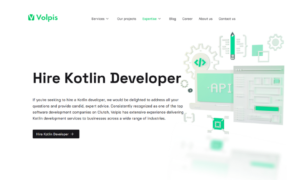If we talk about this century, when technology has skyrocketed, developing an application is somewhere a child’s play. However, developing an optimized application rapidly is still not everyone’s cup of tea. Considering these two factors, this blog post will help you understand whether mobile app development is possible within 10 days or not. A brief overview of Flutter will be discussed alongside the Flutter App development service. Also, it will be taken into consideration that the reader can be a novice, as well as an expert. Therefore, we will make sure that knowledge is imparted into comprehensive segments, from where everyone can understand and implement easily.
Basic overview of Flutter and its benefits
Google developed an open-source framework for developing apps in 2015 and launched it in May 2017 under the name Flutter. The application gained tremendous popularity within a short period, and as of now, 42% of the developers have agreed to have been using Flutter for cross-platform applications. The framework is written in Dart language, which is novel, in the arena of application development. Subsequently, it has enhanced the mobile app development services range because of the single-code database which can be used in Flutter’s engine for multiple Operating Systems (OS).
Benefits of Flutter
- The most significant feature of Flutter is that it enables the developers to use the single-code database for multiple Operating Systems (OS). Thus, it results in cost-efficient mobile app development along with lesser time consumption.
- Developers are also prioritizing this framework over others because of its hot reload system. This allows the engineers to view all the changes simultaneously, and therefore, they are capable of making iterations according to the demands.
- The widget library of Flutter is highly rich. It allows the developers to use already-built widgets for different sections and columns. These widgets can be customized according to the demands of the page.
- The engine of Flutter and its architecture allows developers to build high-performing apps. The native ARM codes are compiled with Flutter apps, thus voiding the demand for the JavaScript bridge to be integrated.
- Device-specific functionalities can also be used during the time of the Flutter app development process, despite being a cross-platform development framework. This is because it provides Native features, such as camera access, geolocation, sensor, etc.
Flutter’s installation
- The work begins by installing the IDE (integrated development environment). The plus point with Flutter is that it can work with various IDEs, for example, Visual Studio Code, Android Studio, or IntelliJ IDEA.
- Check the basic requirements of the operating system, space in the drive, and other tools for installation.
- Go to the Flutter SDK download page and choose your OS (Operating System), and then download the files.
- After the download, extract the file to your computer.
- Verify Flutter installation after the process.
Architecting the UI (User Interface)
The optimum architecture of the app’s User Interface is extremely important, as it will play a major role in determining the viewer’s retention. Go through the points below to learn the essentials for architecting UI during Flutter app development:
1. Goal-setting
The setting of goals before starting the development process is essential as it helps you prototype the entire blue-print and select the right brand voice for your application.
2. Wireframing
Once the idea has been germinated, the next step is to visualize them. There are many tools available to help you give visuals to your ideas, such as Adobe XD, Figma, etc.
3. Theme building
Consider choosing the theme according to your brand’s voice. Take into consideration the typography, color palette, styling, etc., and synchronize them according to the needs. There are many pre-designed themes available on Flutter, however, it is always better to customize your theme.
4. Flutter’s widgets
The widget’s library of Flutter is very rich. You can use a lot of elements from it to design an appealing UI for your application. You can use a container box, Gridview, image, Text field, etc. for your design.
5. Testing
Testing and making iterations is a long-term process that never ends when you want to remain competitive in your industry. Keep your application up-to-date in terms of all the visuals applicable.
Flutter’s state management
The state in Flutter refers to any segment of data that is not static and can change over time. The state management in Flutter, therefore, talks about the management of data and the state. Below are some of the solutions to manage such data:
- Inheritwidget: if the need for your data is applicable for multiple widget designs in the widget tree then Inheritwidget is used. The data is shared across the loop.
- BLoC: Business Logic Component (BLoC) is the separator of business logic from the User Interface (UI). It helps to manage events and handle states.
- Provider: It provides an easy way to access and update the state across the widget tree. This solution simplifies the management of data and is built upon Inheritwidget.
Integrating Functionalities
The rich and modern ecosystem of Flutter is consistently moving towards adding functionalities via varieties of APIs. It enhances the capabilities of the app and makes it versatile. Some of the functionalities are:
- AR/VR: Augmented Reality (AR) and Virtual Reality (VR) are the hot talks of today’s day and age. There are several packages such as arkit_flutter_plugin, arcore_flutter_plugin, or flutter_vr can be used to make integration possible for AR/VR on Flutter.
- Social Media: The data on social media is highly intelligent these days. Companies would like to fetch these data for decision-making. Packages like flutter_facebook_auth, flutter_twitter_login, or google_sign_in can be used for Social Media Integration on Flutter.
- Payments: The eCommerce applications are in high demand and the majority of shopping has gone online. For this purpose packages like stripe_payment, razorpay_flutter, or flutter_braintree, help you to integrate seamless payment gateways.
- Location: The geolocation tracking is important for various purposes. It makes the tasks easier for both parties. Packages like google_maps_flutter, flutter_map, or mapbox_gl can be used to solve this integration.
Quality Assurance and Fixing
Testing and fixing is an ever-evolving process in application development. As the data increases and new updates come into the market, it is mandatory to fix new bugs and assure the quality of your application. Some of the important tests are discussed below:
- Unit testing: To ensure that all the components of your app are working in the right way, and diagnose the bugs in the early stages, it is important to write unit tests. You can use flutter_test or mockito frameworks to make sure the tests are done correctly.
- Widget testing: Widget testing is important to ensure that the interaction of your user with the application is providing them the optimal experience or not.
- UI testing: It is essential to make sure that the flow of your UI is the same across the application. If there are breaks or dissimilarities then such bugs are easily detected. Use frameworks like flutter_test or flutter_automated for UI testing.
- Integration testing: Make sure to check all the third-party integrations you made on your Flutter application. It is highly recommended as it will prevent data breaches and safeguard the privacy of your users.
- Performance testing: Employ tools like Flutter Performance Monitor, Android Profiler, or Xcode to make sure that your application is performing well in terms of speed, battery consumption, data flow, etc.
There are many other tests as well that are recommended for successful app development. For that, you can get in touch with the top Flutter app development companies and gain a better understanding.
Launch
The creation of a mobile application is a time-consuming process, particularly if the individual working on the application is inexperienced or not a skilled strategist. The process calls for considerable time spent studying in addition to careful preparation. After that, the procedures for developing and prototyping the product get underway. After you have done these, you may start the process of development. On the other hand, if you want to create your mobile app with Flutter in only ten days, then absolutely, it is doable. Get in contact with our mobile app development company so that we can figure out the most effective method for building the application utilizing the Flutter framework in a short amount of time.



































